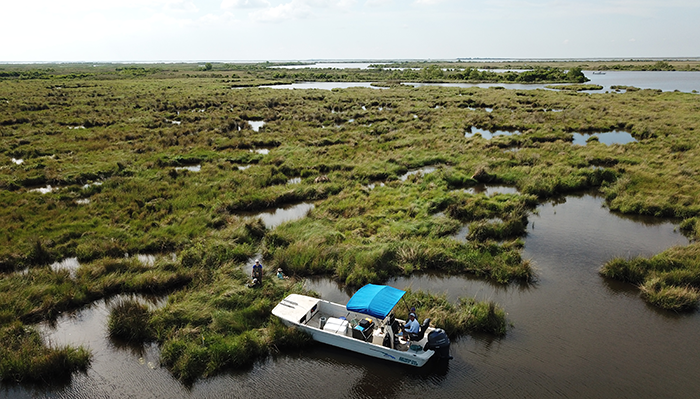Mississippi River diversions and the construction of tidal marshes are key components of the Louisiana Coastal Master Plan, but there is uncertainty about exactly how the management decision to divert water out of the river and into nearby marshes will affect the ecology and functionality of those marshes. With support from the NOAA RESTORE Science Program, Dr. Michael Polito and his team aim to address some of the outstanding questions through characterization of the aquatic food webs of natural and created marshes. Given the long history of restoration projects in the area, Polito’s research takes advantage of the West Pointe à la Hache Siphon, which provides a window into how a small scale diversion can impact a marsh and may provide insights for other larger diversions as well. The siphon was scheduled to reopen after a four year closure in May 2020, but due to the COVID-19 pandemic, that reopening was delayed. Now, almost a year later, the siphon is back on, and Polito and his team are ready to return to the field and collect their data on marsh conditions while the siphon is open.

The West Pointe à la Hache Siphon was constructed in order to mimic the ecological functions of the periodic overbank flooding that naturally occurred before the installation of the Mississippi River flood control levee system. Located on the west bank of the Mississippi River within the Barataria Basin in Plaquemines Parish, Louisiana, the siphon was built to maintain the neighboring brackish marsh. The marsh had experienced saltwater intrusion, which harms the organisms that thrive in less saline environments, so the siphon’s supply of freshwater would minimize this phenomenon. In addition to freshwater from the Mississippi River, the siphon allows the flow through of sediments and nutrients that support marsh growth. As river diversions are a major part of the Louisiana Coastal Master Plan to minimize land loss in coastal Louisiana, studying the effects of the siphon can allow Polito and his team to capture a snapshot of how freshwater addition from river diversions might affect marsh food web ecology. Thus far, the team has found that there are differences between the created and natural marsh communities and food webs during off-siphon conditions. It seems that this is primarily driven by physical characteristics such as the elevation of the marsh and when and how much water inundates the marsh. This summer Polito and his team will see how these relationships hold with the siphon open.
The research team consists of interdisciplinary scientists studying each trophic level of the food web. They are collecting data on nutrients, microbes, invertebrates, and fish, then applying otolith and stable isotope analyses. The stable isotope values of animal tissue reflect diet and habitat use, so this approach provides an independent measure of the structure of marsh food webs that will be integrated into a computer model of the marsh ecosystem. The team can then compare the food web dynamics in both natural and created marsh with and without the influence of the siphon to learn if and how they differ. This understanding can help managers understand the impacts of opening and closing a river siphons and inform the operation and possible future use of larger river diversions. Working with the Louisiana Coastal Protection and Restoration Authority, Polito and his team plan to incorporate their findings directly into the models currently available to evaluate marsh restoration projects. For more information about this research, visit the project website: https://restorefoodweb.lumcon.edu/.
For more information contact Michael Polito [mpolito@lsu.edu].
Written by Jeanne Bloomberg
 Official websites use.gov
A .gov website belongs to an official government organization in the United States.
Official websites use.gov
A .gov website belongs to an official government organization in the United States.
 Secure .gov websites use HTTPS
A lock or https:// means you’ve safely connected to the .gov website. Share sensitive information only on official, secure websites.
Secure .gov websites use HTTPS
A lock or https:// means you’ve safely connected to the .gov website. Share sensitive information only on official, secure websites.